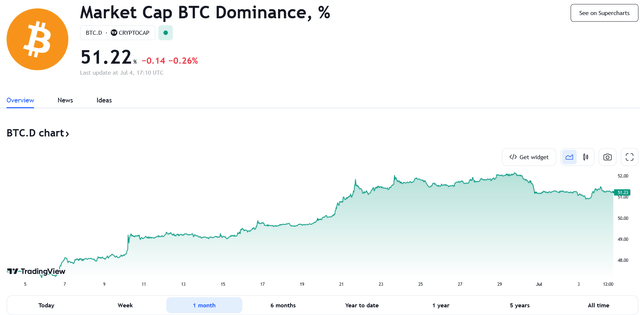monsitj/iStock via Getty Images
Thesis
Many crypto analysts point to the market capitalization of Bitcoin (BTC-USD) to the ratio of altcoins’ market cap – known as Bitcoin dominance and tracked through the Bitcoin Dominance index (BTC.D) – as one of the core metrics in predicting the direction of the crypto market. Bitcoin dominance has been used for years to tell if an alt season or a bearish trend is approaching. However, as the crypto landscape keeps evolving, is Bitcoin dominance still a reliable metric in predicting the direction of the crypto market? Looking at recent Bitcoin dominance data and the current direction of the crypto market, should investors still rely heavily on this metric in making investment choices for the coming weeks and months?
Introduction
Bitcoin has long reigned and remains the dominant force among cryptocurrencies. As the first and most recognized cryptocurrency, Bitcoin continues to capture the attention and investment of individuals and institutions alike. Typically, good news for Bitcoin is good news for crypto, and a step towards the mass adoption of Bitcoin is always a win for the whole crypto landscape. Based on this premise, numerous attempts have been made to regularize Bitcoin, including attempts to get a spot Bitcoin ETF approved by the SEC-the latest being the BlackRock (BLK) ETF filing. The need to introduce regulated investment vehicles like ETFs to help legitimize and establish Bitcoin as a recognized asset class within the traditional financial system has long been sought.
Given Bitcoin’s prominence and influence, it’s no surprise that market observers often use the Bitcoin dominance indicator as a key metric to gauge the overall direction of the crypto market. Bitcoin dominance has been widely utilized to assess the sentiment and health of the crypto market, with fluctuations in this metric often prompting speculation about the rise or fall of altcoins.
Bitcoin dominance chart (TradingView)
Going by the latest Bitcoin dominance data, some analysts have hinted at an imminent alt season as the BTC.D index has shown a slight drop in Bitcoin’s dominance, while BTC maintains sideways momentum.
Bitcoin Dominance Limitations
While Bitcoin dominance may provide some insights, it is far from a perfect measure. In this analysis, I delve briefly into some limitations of Bitcoin dominance as a reliable indicator of crypto market trends. Among other reasons, here are two main reasons why Bitcoin dominance is not a reliable metric in predicting the direction of the current crypto market.
Exclusion of Tokenized Assets
Bitcoin dominance does not consider the impact of tokenized assets or total value locked (‘TVL’) in decentralized finance (DeFi) projects. The rise of tokenization allows for the representation of real-world assets on the blockchain, expanding the scope of the crypto market beyond traditional cryptocurrencies. Tokenized assets, like security tokens, have substantial market value and liquidity but are excluded from the Bitcoin dominance metric.
Evolving Crypto Market and Narratives
The cryptocurrency market is highly dynamic. Disruptive narratives are built using blockchain technology and Bitcoin dominance fails to capture the growth and innovation happening beyond the realm of Bitcoin, disregarding the potential impact of emerging projects that could disrupt the market unexpectedly.
Often, regardless of the Bitcoin dominance indicator and the expected direction of the market based on this indicator, a new crypto narrative could gain traction, create a hype cycle, and push the crypto market into a bull-run trajectory. This has been witnessed in the past. For instance, when the DeFi narrative gained rapid popularity in the summer of 2020, it led to what is now known by the catchphrase “DeFi Summer” and paved the way for the 2021 crypto bull run. New and sustainable narratives that bring incredible use cases to the crypto space have the potential to alter the trend of the crypto market, regardless of what BTC.D depicts. A trending narrative that is capable of driving the next market boom is liquid staking derivatives (LSDs). LSD protocols have recorded impressive growth in total value locked (TVL), especially on the Ethereum (ETH-USD) network.
Conclusion
While Bitcoin dominance has served as a convenient tool for evaluating the trajectory of the crypto market, it is not without its limits. Its inability to adapt to the evolving landscape of cryptocurrencies, the misleading nature of market cap, and the exclusion of tokenized assets limit the metric’s effectiveness.
Typically, when capital invested in Bitcoin starts to decrease following a period of increase in its dominance, the general sentiment is that the capital begins to flow into altcoins. However, there is a lot more going on in the current crypto landscape, and factors that determine bull and bear trends have become more complex. The recent and unexpected SEC scrutiny of major altcoins and the immediate delisting of these altcoins from major US-based exchanges is a clear example of how a factor outside BTC.D can drastically sway investor sentiment. Hence, a nuanced combination of key metrics, technicals, and common sense is vital in navigating the crypto market and properly managing risk.
Contrary to calls of an imminent alt season, I see BTC going through a consolidation phase, moving sideways for a while between the current $28,500 support level and the $32,500 resistance, while alts perform relatively well; however, I do not expect a full-blown alt season yet as I believe investors trust in altcoins have not been fully restored following the recent SEC stance on major alts.






